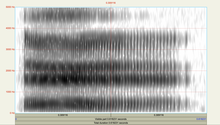| Near-close near-front rounded vowel | |||
|---|---|---|---|
| ʏ | |||
| IPA Number | 320 | ||
| Audio sample | |||
| Encoding | |||
| Entity (decimal) | ʏ | ||
| Unicode (hex) | U+028F | ||
| X-SAMPA | Y | ||
| Braille | |||
| |||
| IPA: Vowels | ||||||||||||||||||||||||||||||||
|---|---|---|---|---|---|---|---|---|---|---|---|---|---|---|---|---|---|---|---|---|---|---|---|---|---|---|---|---|---|---|---|---|
| ||||||||||||||||||||||||||||||||
|
Legend: unrounded • rounded |

The near-close front rounded vowel, or near-high front rounded vowel,[1] is a type of vowel sound, used in some spoken languages.
The symbol in the International Phonetic Alphabet that represents this sound is ⟨ʏ⟩, a small capital version of the Latin letter y, and the equivalent X-SAMPA symbol is Y.
Handbook of the International Phonetic Association defines [ʏ] as a mid-centralized (lowered and centralized) close front rounded vowel (transcribed [y̽] or [ÿ˕]), and the current official IPA name of the vowel transcribed with the symbol ⟨ʏ⟩ is near-close near-front rounded vowel.[2] However, acoustic analysis of cardinal vowels as produced by Daniel Jones and John C. Wells has shown that basically all cardinal front rounded vowels (so not just [y] but also [ø, œ, ɶ]) are near-front (or front-central) in their articulation, so [ʏ] may be just a lowered cardinal [y] ([y˕]), a vowel that is intermediate between cardinal [y] and cardinal [ø].[3] In many languages that contrast close, near-close and close-mid front rounded vowels, there is no appreciable difference in backness between them.[4][5][6][7] In some transcriptions, the vowel is transcribed with ⟨y⟩[8] or ⟨ø⟩.[9] When that is the case, this article transcribes it with the symbols ⟨y˕⟩ (a lowered ⟨y⟩) and ⟨ø̝⟩ (a raised ⟨ø⟩), respectively. ⟨ʏ⟩ implies too weak a rounding in some cases (specifically in the case of the vowels that are described as tense in Germanic languages, which are typically transcribed with ⟨øː⟩), which would have to be specified as ⟨ʏ̹⟩.
In some languages, however, ⟨ʏ⟩ is used to transcribe a vowel that is as low as close-mid but still fits the definition of a lowered and centralized (or just lowered) cardinal [y]. It occurs in German Standard German as well as some dialects of English (such as Estuary),[10][11][12] and it can be transcribed with the symbol ⟨ʏ̞⟩ (a lowered ⟨ʏ⟩) in narrow transcription. For the close-mid front rounded vowel that is not usually transcribed with the symbol ⟨ʏ⟩ (or ⟨y⟩), see close-mid front rounded vowel.
In most languages, the rounded vowel is pronounced with compressed lips (in an exolabial manner). However, in a few cases, the lips are protruded (in an endolabial manner), such as in Swedish, which contrasts the two types of rounding.
- ^ While the International Phonetic Association prefers the terms "close" and "open" for vowel height, many linguists use "high" and "low".
- ^ International Phonetic Association (1999), pp. 13, 171, 180.
- ^ Geoff Lindsey (2013) The vowel space, Speech Talk
- ^ Szende (1994), p. 92.
- ^ Engstrand (1999), p. 140.
- ^ Lodge (2009), p. 87.
- ^ Peters (2017), p. ?.
- ^ For example, by Collins & Mees (2013:225) and Szende (1994:92).
- ^ For example by Chen & Gussenhoven (2015:328); Basbøll & Wagner (1985:40), cited in Basbøll (2005:48) and Peters (2017:?).
- ^ Hall (2003), pp. 93–94, 107.
- ^ Dudenredaktion, Kleiner & Knöbl (2015), pp. 34, 64.
- ^ Altendorf & Watt (2004), pp. 188, 191.

